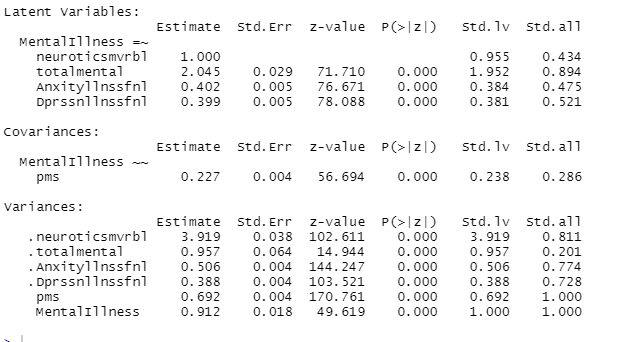Aella recently wrote a post about PMS and neuroticism, finding that they correlate at 0.23. Using her own data, I have suggestive evidence that the correlation adjusted for unreliability is somewhere around 0.36.
This is her measurement of PMS symptoms:
She also has a measurement of neuroticism, anxiety, sexual assault, total mental illness, and depression. Using these, one can build a latent variable and see if it correlates with PMS symptoms.
It’s debatable as to whether experiencing sexual assault as an adult counts as an indicator of neuroticism. More neurotic girls are probably more likely to get sexually assaulted, and sexual assault is going to cause mental harm in the short term. A more uncharitable judgement is that what constitutes sexual assault is not definitive, and neurotic girls are more likely to label grey sexual encounters as rapes.
In addition, many girls selected an unusual amount of mental illnesses. It’s not clear, a priori, if a girl who selected 10 mental illnesses is much more mentally ill than a girl who selected 5. Because of this, I am winsorizing all girls who selected more than 8 mental illnesses to 8.
Measurement error is something that is important to address, as adjusting for it when doing heritability estimates of personality causes them to increase from about 50% to 80%. I would assume the same applies for normal correlations as well. Structural Equation Models can be used to adjust for the measurement error that you observe within your data. It does this by modeling latent variable from a set of observed variables, and then relating that variable to other variables. In this article, I use DWLS estimation as several of the variables do not have a normal distribution, so ML yields poor fit statistics. Alternatively, a simple mathematical formula can be used to correct for unreliabiltiy.
Here is the summary of the output of different methods used for calculating the correlation between neuroticism and PMS:
Method 1: Structural Equation Model with all 5 mental illness variables.
Result: latent correlation of 0.292
Fit statistics: not great, but somewhat passable:
Method 2: Structural Equation Model excluding sexual assault variable.
Result: latent correlation of 0.286.
Fit statistics: worse than model 1.
Method 3: Structural Equation Model excluding mental illness variable.
Result: latent correlation of 0.378.
Fit statistics: appropriate.
Method 4: Structural Equation Model with only neuroticism, anxiety, and depression.
Result: latent correlation of 0.358.
Fit statistics: the best.
Method 5: calculate MIRT factor score using depression/anxiety/neuroticism then adjusting for unreliability (rxx = .52).
The correlation between general neuroticism and PMS adjusted for unreliability is 0.261/sqrt(0.52)=0.362, roughly the same as the result from the SEM models.
It’s worth noting that this method only corrects for the measurement error inside the data itself. It cannot correct for the fact that self-reports are not always accurate indicators of personality. As such, I suspect the true correlation between latent neuroticism and PMS symptoms is closer to 0.4 or 0.5.
Why does neuroticism and PMS correlate?
Aella brought up this finding in the context of the geography of madness, a book which theorizes that many western mental illnesses such as PMS are actually culturally bound syndromes. Alternatively, it could be that hormonal fluctuations experienced during the luteal phase have an amplifying effect on an individual’s personality. Explained graphically:















publication needs TTS homie